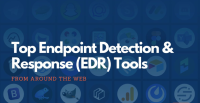What is an EDR Tools?
Endpoint detection and response (EDR) software is a set of cybersecurity solutions that spot anomalies and threats on endpoints such as phones and computers and trigger reaction processes for the security team. By giving enterprises network visibility, these solutions shorten their time to identify and neutralize threats. EDR is essential for preventing attacks before they reach a company’s network because human error accounts for many vulnerabilities.

EDR tools also monitor endpoints to spot unusual actions like an employee inserting a USB device and then accessing private data. The platform will flag this behaviour for the IT team to investigate.
How do EDR tools work?
Data from endpoints, such as event logs, active apps, and failed authentication attempts, is continuously ingested by EDR solutions. The typical procedure is as follows:
Data correlation and analysis
Machine learning is used in the solution to correlate and evaluate the data. The solution typically uses this technology to build a baseline of typical endpoint operations and user behaviour before searching for anomalies.
Threat intelligence feeds, which provide the context of actual cyberattack examples, are a feature of several EDR platforms. The system analyzes network and endpoint activity with these samples to identify attacks.
Identifying and addressing the suspicious activity
The solution detects suspicious activities and alerts, necessary people, and security analysts. Additionally, it starts automated replies in response to preset triggers. Using temporary endpoint isolation, for instance, to prevent malware from spreading throughout the network.
Preserving information for later use
Data storage is a feature of EDR solutions that enables proactive threat hunting and future investigations. With this data, analysts and tools can evaluate ongoing lengthy or previously unreported attacks by combining occurrences into a single incident. Additionally, it can give context for threat hunting, assisting security professionals and tools in actively searching for malicious activities.
The benefits of using an EDR tools
Organizations should search for solutions with the following features when selecting an EDR tool.
Threat identification
EDR software should run routine endpoint scans to look for malware hidden on the system. For instance, EDR might quarantine a suspect folder that a worker unintentionally downloaded until IT can investigate it. Users can eliminate these persistent threats before they acquire access to the network by quickly identifying them.
Monitoring
EDR solutions should perform periodic scans in addition to real-time endpoint monitoring. Monitoring detects unusual activity and notifies IT, enabling them to lock access to secure data while they address the problem. Certain EDR solutions can block a device’s access to the network if they see questionable activity. The system may lock employees until IT can investigate and restore their access.
Both whitelists and blacklists
Even if some apps are valid, the EDR tool may transmit flags to IT. Companies require the option to whitelist programmes that they want to allow in certain situations without seeking IT permission. Alternatively, the platform can block access to programmes it has identified as malicious by blocklisting them.
Automatic response to threats
Threats do not always occur during business hours, so EDR platforms must be able to start response mechanisms independently without IT assistance. Automatic threat response quarantines possible threats and inhibits suspicious activity until IT can investigate it. Only when EDR tools relate to other cybersecurity systems like security information and event management (SIEM) or zero trust systems can the functionality of automatic response increase.
Understanding Endpoint Protection Options: EDR vs Antivirus EDR Tools
Endpoint detection and response (EDR) gathers information from endpoints and offers sophisticated methods for spotting threats, with the capacity to pinpoint the source of an attack and how it is spreading.
Understand how these can help safeguard your business by understanding the differences between EDR, antivirus software, and endpoint protection platforms (EPP).
See Also:
